An Energy Efficient Train Dispatch and Control Integrated Method in Urban Rail Transit
Abstract
:1. Introduction
2. Related Works
2.1. The Optimal Train Driving Method
2.2. The Energy Efficient Timetable Method
2.3. The Train Dispatch and Control Integrated Method
3. The Proposed Energy Efficient Integrated Method
3.1. Definitions
- -
- Short section: a train can travel across a section within a given trip time though one time of traction;
- -
- Long section: a train needs at least two times of traction to run through a section within a given trip time;
- -
- The tractive energy (TE): the energy needed for traction by all the trains on the line;
- -
- The tractive energy consumption (TEC): the energy drawn from the substations for traction by all the trains;
- -
- The regenerative energy (RE): the regenerative energy generated by all the trains;
- -
- The regenerative energy consumption (REC): the regenerative energy consumed by all the trains.
3.2. The Time Slot and Energy Grid Model
3.3. Energy Efficient Integrated Strategy
- -
- The utilization of regenerative energy among multiple bidirectional running trains within the same electrical section is considered.
- -
- The actual division of electrical sections and the additional resistance of a train are considered, which make the results more realistic.
- -
- No limitation on the times of train traction in a section is needed. The utilization of regenerative energy can take place anywhere in sections.
- -
- A unified strategy is designed for both short section and long section scenarios.
- -
- The mutual constraints among the headway, the running time and the dwell time of trains are loose.
- -
- The proposed method is more energy efficient than the existing method in different scenarios.
4. Energy-Saving Optimization Model
4.1. Parameters
| the number of speed profiles of the ith section; | |
| the timetable specified running time of trains in the ith section; | |
| the running time of the ith section when the jth speed profile is adopted; | |
| the number of time slots of the running time in the ith section when the jth speed profile is adopted; | |
| the dwell time of trains at the ith station; | |
| the number of time slots of the dwell time at the ith station; | |
| the time slot that the train departs from the ith section; | |
| the time slot at the end of the down, up directional running; | |
| the headway; | |
| the number of time slots of the headway; | |
| the turn back time; | |
| the number of time slots of the turn back time; | |
| the tractive force of a train (in KN) at the kth time slot of the ith station when the jth speed profile is adopted; | |
| the braking force of a train at the kth time slot (in KN); | |
| the basic resistance of a train at the kth time slot (in KN); | |
| the starting resistance of a train at the kth time slot (in KN); | |
| the additional resistance of a train at the kth time slot (in KN); | |
| the running resistance of a train at the kth time slot (in KN); | |
| the resultant force of a train at the kth time slot (in KN); | |
| , | the mass of a motor car (in tons); |
| , | the mass of a trailer car (in tons); |
| , | the number of cars of a train; |
| g, | the equivalent additional slope of the line; |
| , | the speed of a train at the kth time slot if the jth speed profile of the ith section is adopted; |
| , | the position of a train at the kth time slot if the jth speed profile of the ith section is adopted; |
| , | the acceleration of a train (in ) at the kth time slot; |
| , | the rotary mass coefficient; |
| m, | the mass of a train (in tons); |
| , | the energy needed for traction by all the trains at the kth time slot; |
| , | the conversion efficiency coefficient of the tractive energy; |
| , | the regenerative energy generated by all the trains at the kth time slot; |
| , | the conversion efficiency coefficient of the regenerative braking energy; |
| , | the consumed regenerative energy by all the trains at the kth time slot; |
| , | the tractive energy consumption at the kth time slot; |
| , | the sum of the TEC of each time slot; |
| , , | the starting position, the ending position of the zth electrical section; |
| , , | the minimum running time of trains in the ith section; |
| , | the adjustment rang of running time; |
| , , | the minimum dwell time of trains at the ith station; |
| , , | the maximum dwell time of trains at the ith station; |
| , | the speed limitation of the line at the position ; |
| , | the speed limitation of the train; |
| D, | the length of the line; |
| , | the average traveling speed of a train (in km/h); |
| , | the vector of running time; |
| , , , | the number of extended, unchanged and shortened running time; |
| , | the vector of dwell time; |
| , , , | the number of extended, unchanged and shortened dwell time. |
4.2. Definition of the Objective Function
4.3. Energy Saving Optimization Model
- (1)
- The constraint on the running time of trains in the up direction of the ith section.
- (2)
- The constraint on the difference between the adopted running time and the timetable specified running time in the up direction of the ith section.
- (3)
- The constraint on the dwell time of trains in the up direction at the ith station.
- (4)
- The constraint on the running time of trains in the down direction of the ith section.
- (5)
- The constraint on the difference between the adopted running time and the timetable specified running time in the down direction of the ith section.
- (6)
- The constraint on the dwell time of trains in the down direction at the ith station.
- (7)
- The constraint on the speed of a train.
- (8)
- The constraint on the position of a train.
5. Simulation and Discussion
5.1. The Genetic Algorithm Used in Simulation
5.2. Simulation of Long Section Scenario
5.3. Simulation of Short Section Scenario
5.4. Discussion
5.4.1. Long Section Big Headway Scenario
5.4.2. Long Section Small Headway Scenario
5.4.3. Short Section Big Headway Scenario
5.4.4. Short Section Small Headway Scenario
6. Conclusions
Author Contributions
Acknowledgments
Conflicts of Interest
References
- Yang, X.; Li, X.; Ning, B.; Tang, T. A survey on energy-efficient train operation for urban rail transit. IEEE Trans. Intell. Transp. Syst. 2016, 17, 2–13. [Google Scholar] [CrossRef]
- Chen, J.; Cheng, S.; Nikic, V.; Song, M. Quo Vadis? Major Players in Global Coal Consumption and Emissions Reduction. Transf. Bus. Econ. 2018, 17, 112–132. [Google Scholar]
- González-Gil, A.; Palacin, R.; Batty, P.; Powell, J. A systems approach to reduce urban rail energy consumption. Energy Convers. Manag. 2014, 80, 509–524. [Google Scholar] [CrossRef]
- Takagi, R. Energy saving techniques for the power feeding network of electric railways. IEEJ Trans. Electr. Electron. Eng. 2010, 5, 312–316. [Google Scholar] [CrossRef]
- Kondo, K. Recent energy saving technologies on railway traction systems. IEEJ Trans. Electr. Electron. Eng. 2010, 5, 298–303. [Google Scholar] [CrossRef]
- González-Gil, A.; Palacin, R.; Batty, P. Sustainable urban rail systems: Strategies and technologies for optimal management of regenerative braking energy. Energy Convers. Manag. 2013, 75, 374–388. [Google Scholar] [CrossRef]
- Su, S.; Tang, T.; Chen, L.; Liu, B. Energy-efficient train control in urban rail transit systems. Proc. Ins. Mech. Eng. Part F 2015, 229, 446–454. [Google Scholar] [CrossRef]
- Wong, K.; Ho, T. Coast control of train movement with genetic algorithm. In Proceedings of the 2003 Congress on Evolutionary Computation, Canberra, Australia, 8–12 December 2003; Volume 2, pp. 1280–1287. [Google Scholar]
- Wong, K.K.; Ho, T.K. Dynamic coast control of train movement with genetic algorithm. Int. J. Syst. Sci. 2004, 35, 835–846. [Google Scholar] [CrossRef] [Green Version]
- Chang, C.; Sim, S. Optimising train movements through coast control using genetic algorithms. IEE Proc.-Electr. Power Appl. 1997, 144, 65–73. [Google Scholar] [CrossRef]
- Bocharnikov, Y.; Tobias, A.; Roberts, C.; Hillmansen, S.; Goodman, C. Optimal driving strategy for traction energy saving on DC suburban railways. IET Electr. Power Appl. 2007, 1, 675–682. [Google Scholar] [CrossRef]
- Yong, D.; Haidong, L.; Yun, B.; Fangming, Z. A two-level optimization model and algorithm for energy-efficient urban train operation. J. Transp. Syst. Eng. Inf. Technol. 2011, 11, 96–101. [Google Scholar]
- Tian, Z.; Hillmansen, S.; Roberts, C.; Weston, P.; Chen, L.; Zhao, N.; Su, S.; Xin, T. Modeling and simulation of DC rail traction systems for energy saving. In Proceedings of the 2014 IEEE 17th International Conference on Ntelligent Transportation Systems (ITSC), Qingdao, China, 8–11 October 2014; pp. 2354–2359. [Google Scholar]
- Milroy, I.P. Aspects of Automatic Train Control. Ph.D. Thesis, Loughborough University, Loughborough, UK, 1980. [Google Scholar]
- Howlett, P. The Optimal Control of a Train. Ann. Oper. Res. 2000, 98, 65–87. [Google Scholar] [CrossRef]
- Gong, C.; Zhang, S.; Zhang, F.; Jiang, J.; Wang, X. An integrated energy-efficient operation methodology for metro systems based on a real case of Shanghai metro line one. Energies 2014, 7, 7305–7329. [Google Scholar] [CrossRef]
- Yang, X.; Li, X.; Gao, Z.; Wang, H.; Tang, T. A cooperative scheduling model for timetable optimization in subway systems. IEEE Trans. Intell. Transp. Syst. 2013, 14, 438–447. [Google Scholar] [CrossRef]
- Yang, X.; Ning, B.; Li, X.; Tang, T. A two-objective timetable optimization model in subway systems. IEEE Trans. Intell. Transp. Syst. 2014, 15, 1913–1921. [Google Scholar] [CrossRef]
- Peña-Alcaraz, M.; Fernández, A.; Cucala, A.P.; Ramos, A.; Pecharromán, R.R. Optimal underground timetable design based on power flow for maximizing the use of regenerative-braking energy. Proc. Inst. Mech. Eng. Part F 2012, 226, 397–408. [Google Scholar] [CrossRef]
- Li, X.; Wang, D.; Li, K.; Gao, Z. A green train scheduling model and fuzzy multi-objective optimization algorithm. Appl. Math. Modell. 2013, 37, 2063–2073. [Google Scholar] [CrossRef]
- Albrecht, T. Reducing power peaks and energy consumption in rail transit systems by simultaneous train running time control. WIT Trans. State Art Sci. Eng. 2010, 39. [Google Scholar] [CrossRef]
- Nasri, A.; Moghadam, M.F.; Mokhtari, H. Timetable optimization for maximum usage of regenerative energy of braking in electrical railway systems. In Proceedings of the 2010 International Symposium on Power Electronics Electrical Drives Automation and Motion (SPEEDAM), Pisa, Italy, 14–16 June 2010; pp. 1218–1221. [Google Scholar]
- Bu, B.; Ding, Y.; Li, C.; Mao, X. Research on integration of train control and train scheduling. J. China Railw. Soc. 2013, 35, 64–71. [Google Scholar]
- Su, S.; Li, X.; Tang, T.; Gao, Z. A subway train timetable optimization approach based on energy-efficient operation strategy. IEEE Trans. Intell. Transp. Syst. 2013, 14, 883–893. [Google Scholar] [CrossRef]
- Su, S.; Tang, T.; Roberts, C. A Cooperative Train Control Model for Energy Saving. IEEE Trans. Intell. Transp. Syst. 2015, 16, 622–631. [Google Scholar] [CrossRef]
- Chen, E.; Yang, X.; Ding, Y. An energy-efficient adjustment approach in subway systems. In Proceedings of the IEEE International Conference on Intelligent Transportation Systems, Qingdao, China, 8–11 October 2014; pp. 2774–2779. [Google Scholar]
- Chen, E.; Bu, B.; Sun, W. An Energy-Efficient Operation Approach Based on the Utilization of Regenerative Braking Energy Among Trains. In Proceedings of the IEEE International Conference on Intelligent Transportation Systems, Las Palmas, Spain, 15–18 September 2015; pp. 2606–2611. [Google Scholar]
- Liu, W.; Li, Q.; Bing, T. Energy saving train control for urban railway train with multi-population genetic algorithm. In Proceedings of the 2009 International Forum on Information Technology and Applications, Chengdu, China, 15–17 May 2009; Volume 2, pp. 58–62. [Google Scholar]
- Liao, G.C. A novel evolutionary algorithm for dynamic economic dispatch with energy saving and emission reduction in power system integrated wind power. Energy 2011, 36, 1018–1029. [Google Scholar] [CrossRef]
- Alaca, F.; Sediq, A.B.; Yanikomeroglu, H. A genetic algorithm based cell switch-off scheme for energy saving in dense cell deployments. In Proceedings of the 2012 IEEE Globecom Workshops (GC Wkshps), Anaheim, CA, USA, 3–7 December 2012; pp. 63–68. [Google Scholar]
- Abramson, D.; Mills, G.; Perkins, S. Parallelisation of a genetic algorithm for the computation of efficient train schedules. Parallel Comput. Transp. 1994, 37, 139–149. [Google Scholar]
- Han, S.H.; Byen, Y.S.; Baek, J.H.; An, T.K.; Lee, S.G.; Park, H.J. An optimal automatic train operation (ATO) control using genetic algorithms (GA). In Proceedings of the 1999 IEEE Region 10 Conference, Cheju Island, Korea, 15–17 September 1999; Volume 1, pp. 360–362. [Google Scholar]
- Li, Y.; Hou, Z. Study on energy-saving control for train based on genetic algorithm. J. Syst. Simul. 2007, 2, 38. [Google Scholar]
- Chung, J.W.; Oh, S.M.; Choi, I.C. A hybrid genetic algorithm for train sequencing in the Korean railway. Omega 2009, 37, 555–565. [Google Scholar] [CrossRef]
- Zhang, Y.S.; Jin, W.D. Model and algorithm for train operation adjustment on single-track railways based on genetic algorithm. J. Southwest Jiaotong Univ. 2005, 40, 147–152. [Google Scholar]


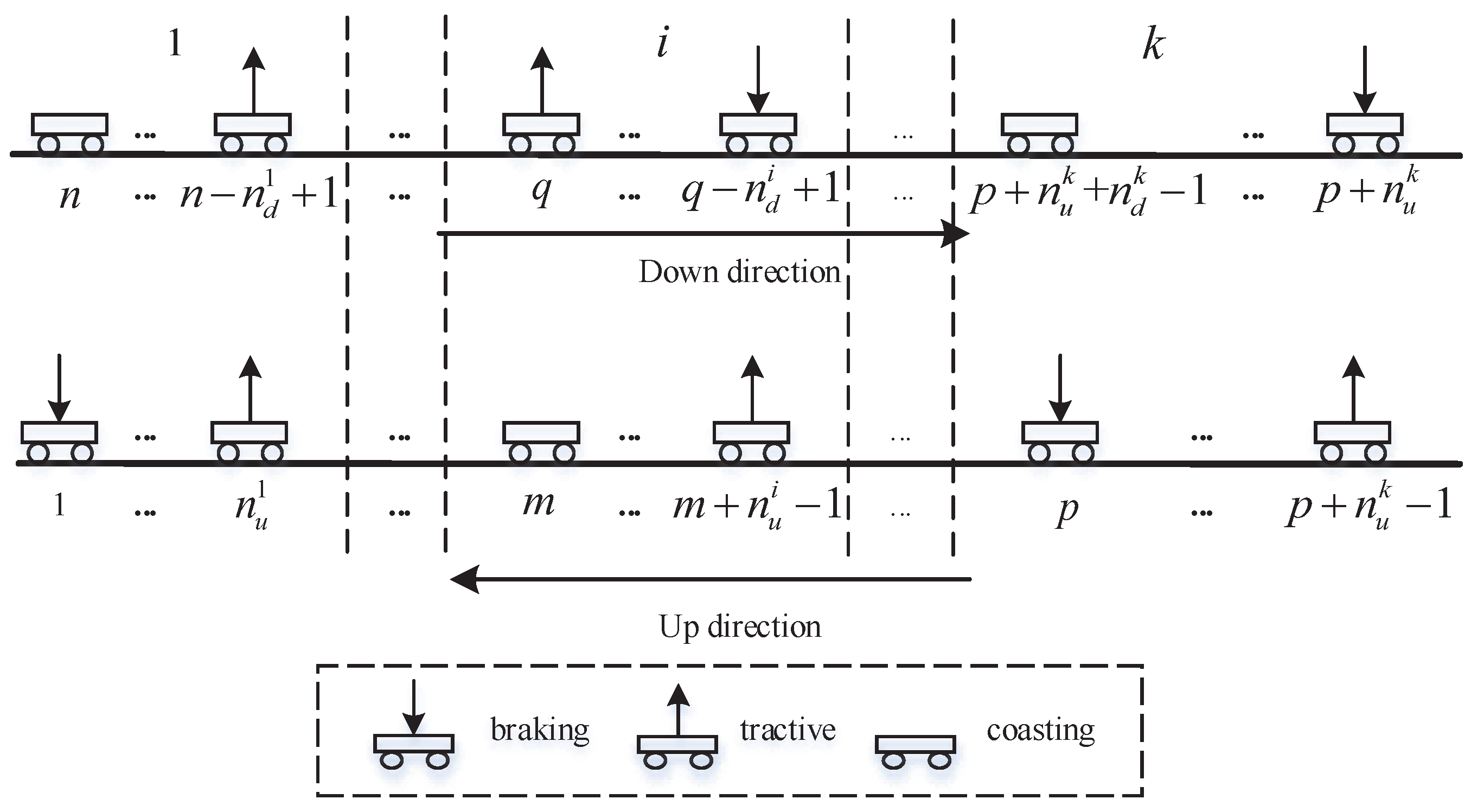
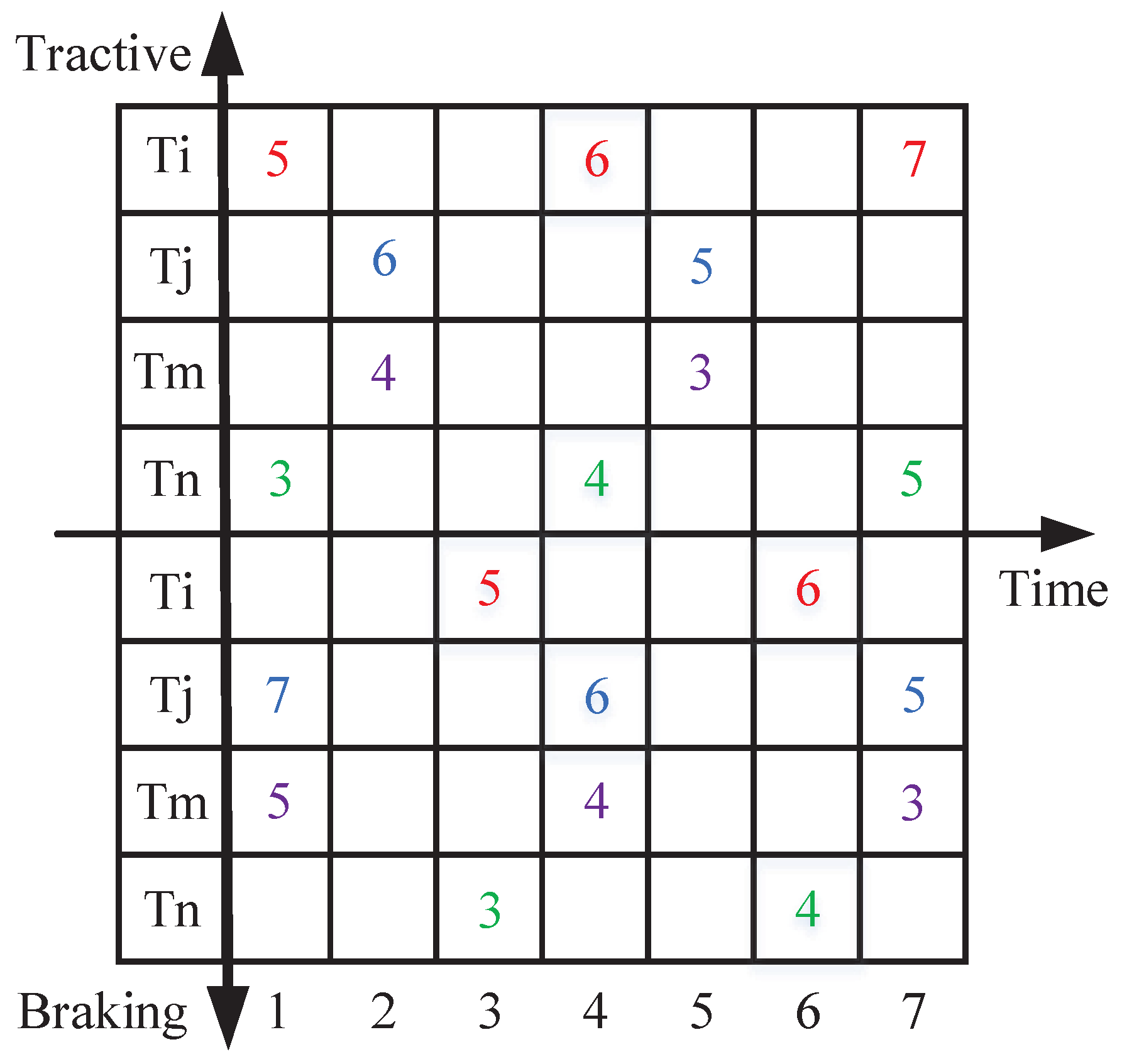
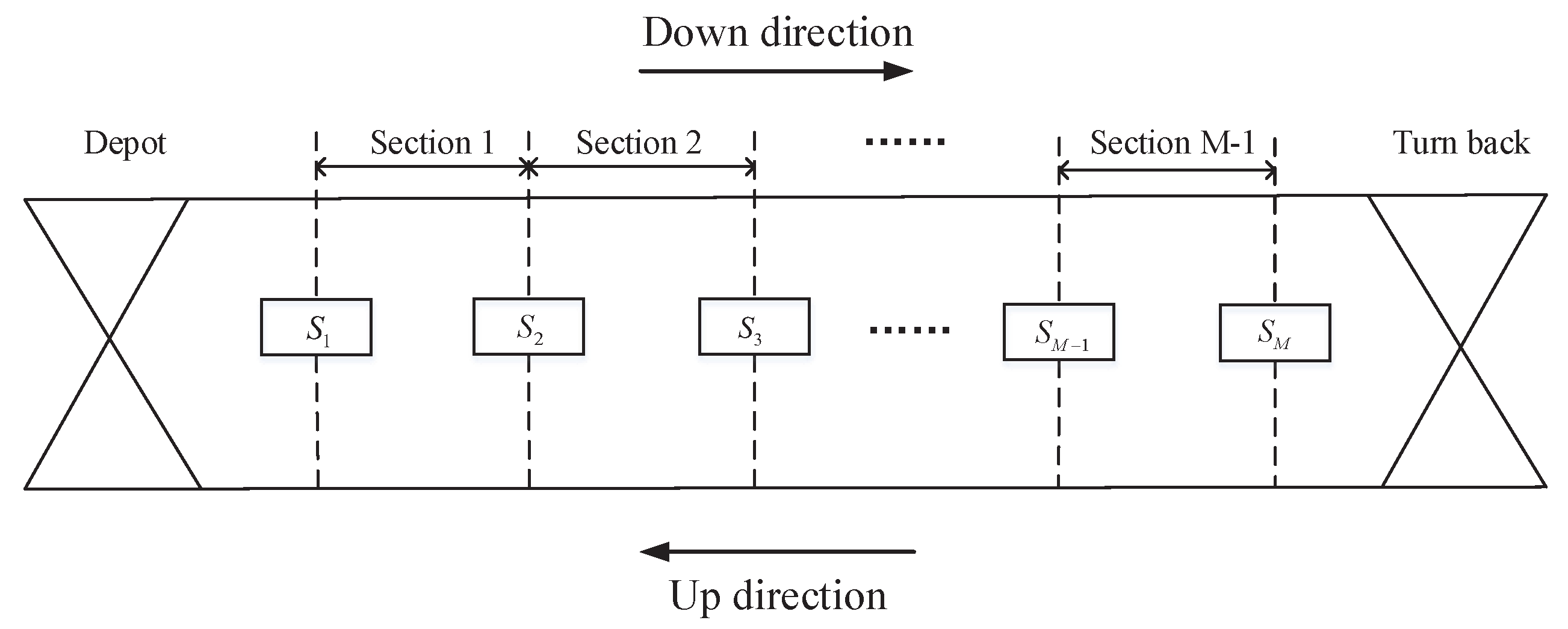
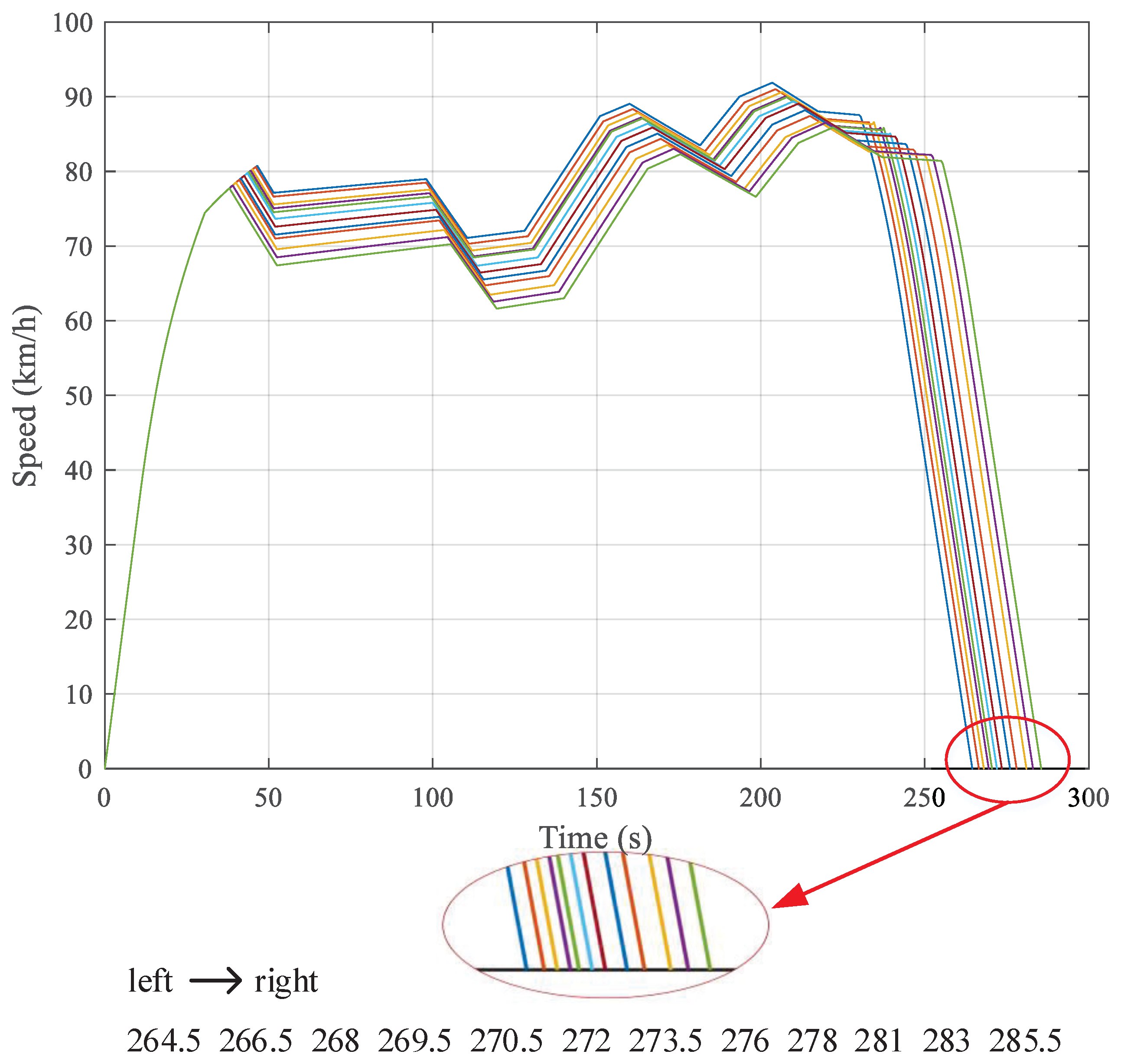

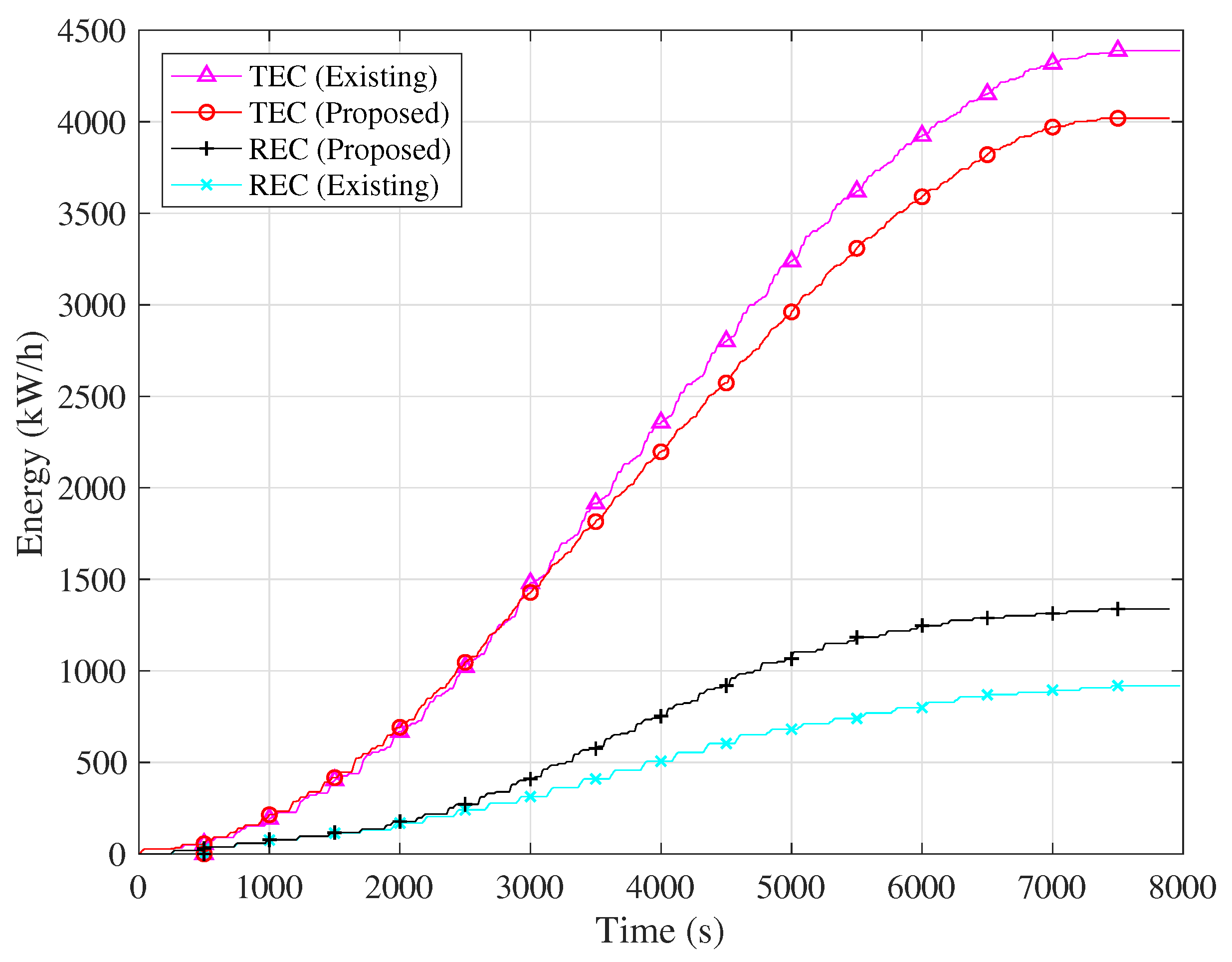
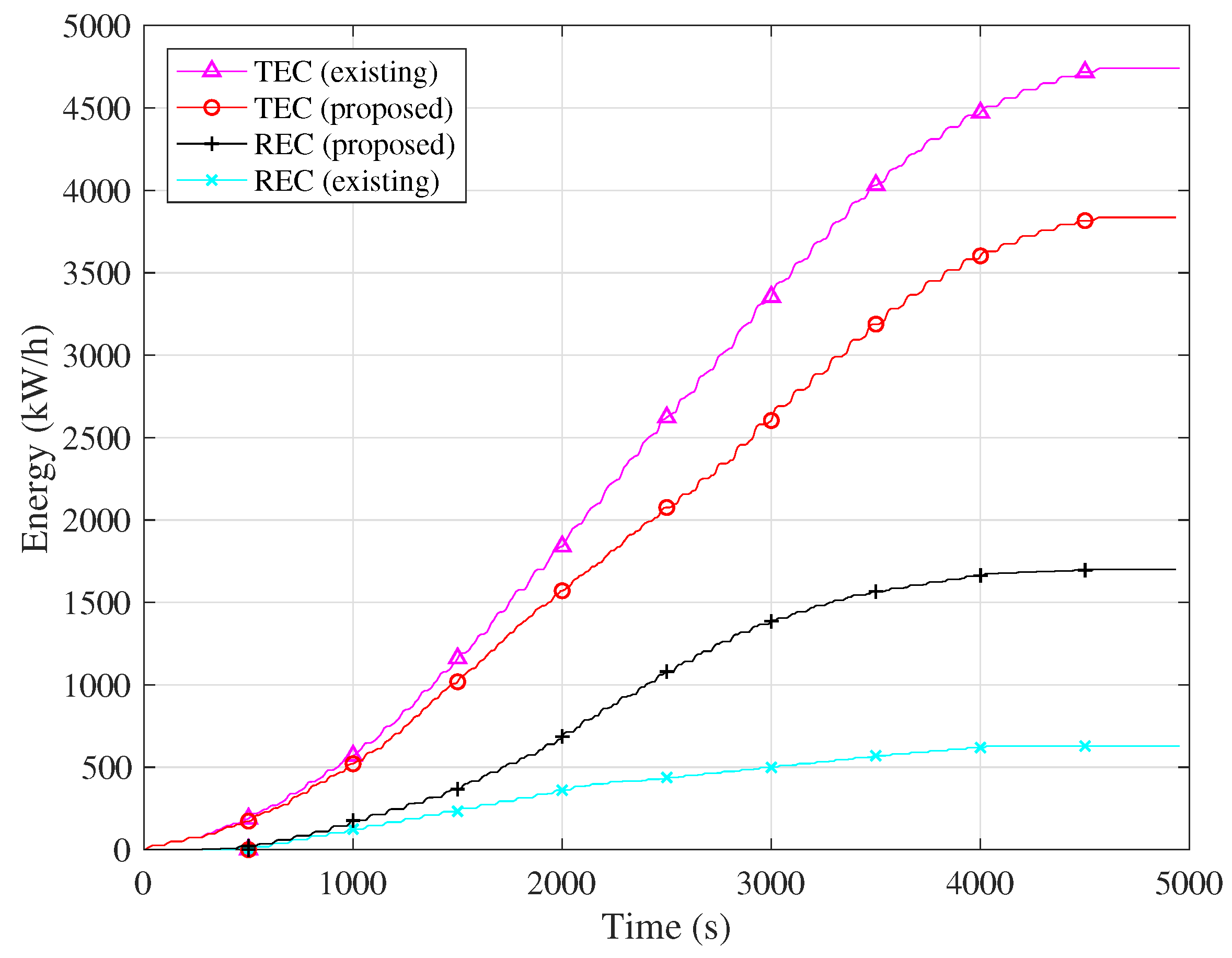
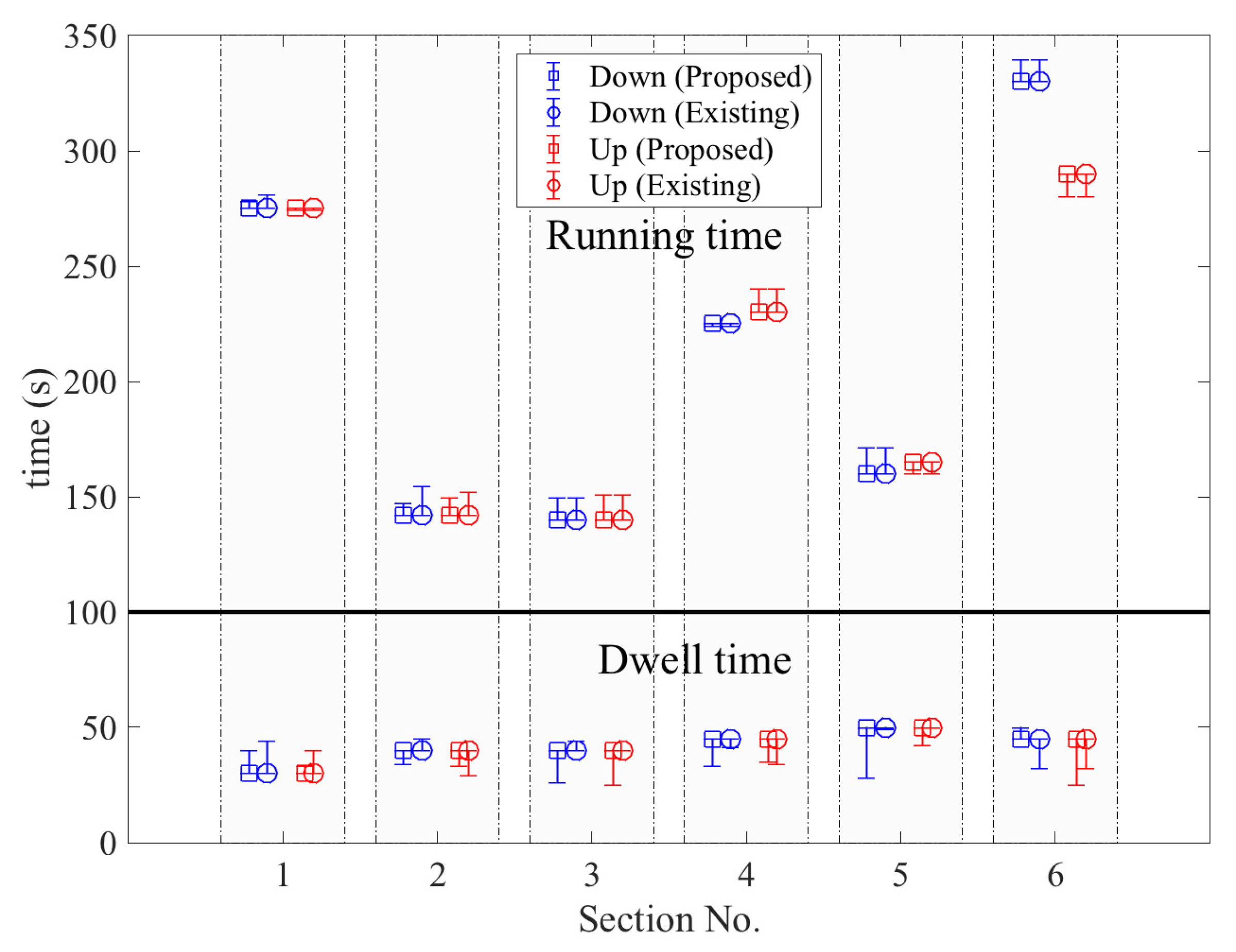
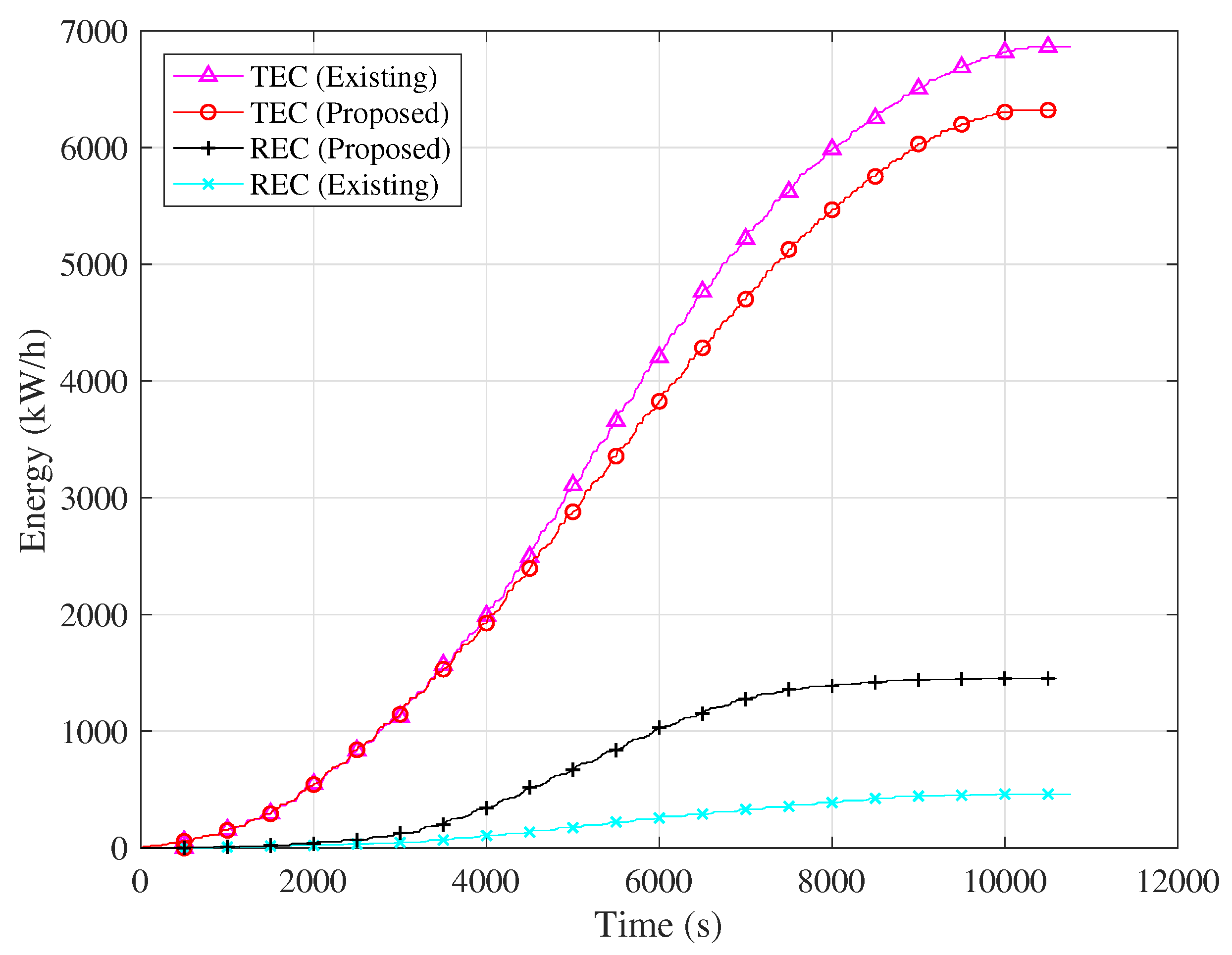


| Headway | Methods | TEC (kWh) | REC (kWh) | Run time (s) | Dwell time (s) | (km/h) |
|---|---|---|---|---|---|---|
| 240 s | Timetable | 5616.3 | 0 | 2514 | 500 | 44.52 |
| Existing | 4388.8 | 919.1 | 2576.6 | 474 | 44.05 | |
| Proposed | 4015.7 | 1348.4 | 2563.5 | 404 | 45.13 | |
| 90 s | Existing | 4740.9 | 629 | 2571.5 | 453 | 44.38 |
| Proposed | 3835.5 | 1700.3 | 2531.5 | 476 | 44.61 |
| Headway | Methods | TEC (kWh) | REC (kWh) | Run Time (s) | Dwell Time (s) | (km/h) |
|---|---|---|---|---|---|---|
| 300 s | Timetable | 8578.4 | 0 | 3322 | 840 | 35.98 |
| Existing | 6862.3 | 461 | 3532 | 1019 | 33.15 | |
| Proposed | 6284.2 | 1444.9 | 3454.5 | 932 | 34.29 | |
| 90 s | Existing | 5027.8 | 2895.4 | 3430 | 1007 | 33.93 |
| Proposed | 4281.3 | 3789.7 | 3420.5 | 1026 | 33.86 |
© 2018 by the authors. Licensee MDPI, Basel, Switzerland. This article is an open access article distributed under the terms and conditions of the Creative Commons Attribution (CC BY) license (http://creativecommons.org/licenses/by/4.0/).
Share and Cite
Bu, B.; Qin, G.; Li, L.; Li, G. An Energy Efficient Train Dispatch and Control Integrated Method in Urban Rail Transit. Energies 2018, 11, 1248. https://doi.org/10.3390/en11051248
Bu B, Qin G, Li L, Li G. An Energy Efficient Train Dispatch and Control Integrated Method in Urban Rail Transit. Energies. 2018; 11(5):1248. https://doi.org/10.3390/en11051248
Chicago/Turabian StyleBu, Bing, Guoying Qin, Ling Li, and Guojie Li. 2018. "An Energy Efficient Train Dispatch and Control Integrated Method in Urban Rail Transit" Energies 11, no. 5: 1248. https://doi.org/10.3390/en11051248





